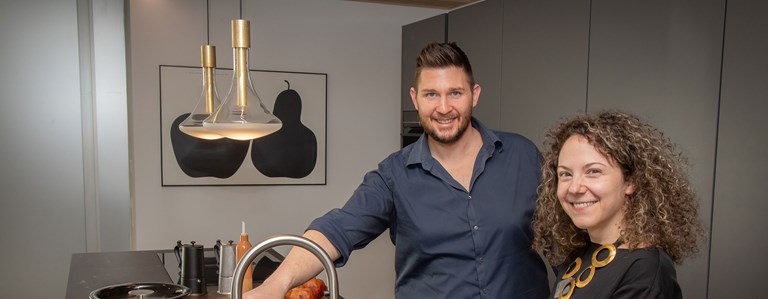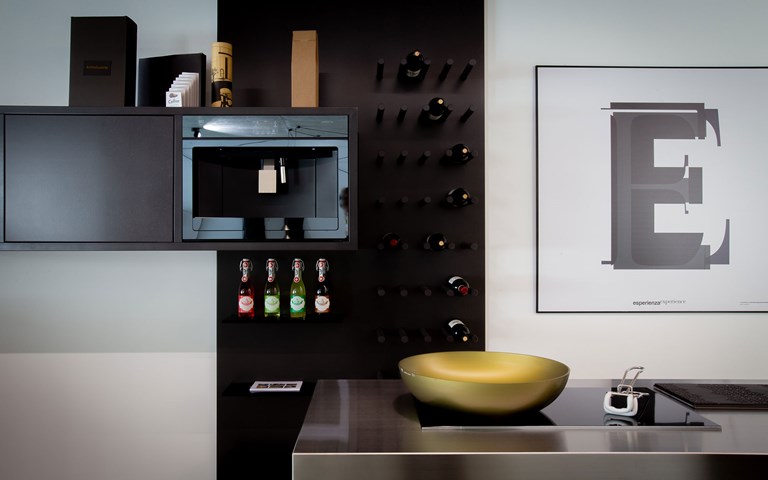
Island of dreams
Before the pandemic the island of dreams was a tropical atoll, when exotic travel became a mirage, the most coveted island became the one in the middle of the kitchen or, to put it as an interior designer the living area of a house.
It’s the result of an imaginary idea that comes from movies and series “made in the USA”, but also from a change in habits. With bars, restaurants and other meeting places that have been closed for long periods, the home has taken on the value of search for comfort to rediscover the conviviality lost. This is the reason why we would like to reproduce inside the home that climate that we breathed in outside. We talked about it with Alessandro Invernizzi and Chiara Giovannini of Rovere Interni, the space dedicated to interior decoration
in the Birreria District of Grono.

The pandemic has changed the market of furniture and in particular of kitchens?
“Undoubtedly being at home more means you want to invest more in having a more comfortable and functional home. Regarding the kitchen, it should also be added that for some time now, with the success of entertainment programs that have transformed chefs into TV stars, the attention has increased to choose high-profile solutions, both technological and aesthetic. Moreover, the kitchen increasingly contaminates the living area, spaces that are more and more becoming places to live. This is a trend that has been consolidated for some time”
These are the reasons that see the island or the peninsula become more and more the heart of the living area?
“We could say that the island has become our own little American dream. We’ve seen it in hundreds of scenes of family life in Hollywood movies or in TV series. It has now become part of our imagination. On the other hand, the island or peninsula in the kitchen also responds to needs, not only aesthetic but also of practicality. It is a surface that can replace the dining table. For example, in some solutions concealed tops to create an extension to sit down and eat.
The impression is that they also facilitate socializing.
“Yes, they do. They are a way to convivial cooking, but also to get out of it without having to having to invent excuses to get up from the table. It creates a less formal environment. Somehow it’s as if trying to reproduce those experiences at home that we were looking for in the clubs, where, before the pandemic, you were at the bar, or sitting on stools, we shared long tables even with strangers. Now happy hour and “apericena” we have moved them to the kitchen”.
You don’t run the risk of “frying”, cooking in a place without a hood?
“Today, technological solutions also overcome the inconvenience of fumes and vapors that cooking on an island can generate. More and more, we use integrated suction systems in modern induction hobs, at the center of the powerful aspirators that suck fumes and vapors into them as soon as they leave the pot or pan”.
Is the kitchen therefore increasingly hi-tech?
“Yes. The new appliances are inspired by the concepts of home automation and new systems of artificial intelligence. They have Wi-Fi and can be programmed or controlled remotely, or connected to systems of management, such as Alexa. They have infinite possibilities of use, let’s say for now most of us use a very small percentage of them. Those who do, however, appreciate the convenience, because it simplifies everyday life: we don’t have to remember or worry about many routine operations, of timers that ring and we don’t hear, and so on and on.”
Are they therefore kitchens that consume more? Or is there attention to the theme environmental impact?
“The focus is increasingly on energy saving. Today there is a lot of attention in improving the energy performance of household appliances. In general, the theme of sustainability is increasingly present in the production of furnishings. The materials are enhanced with a natural matrix: wood, stone, glass. These are materials that are obviously subjected to technological processes that make them not only sustainable and low environmental impact, but also safe and durable.
For example, porcelain stoneware kitchen tops are increasingly used for the performance and guarantees they offer.”
Has the pandemic affected on the evolution of research in furniture?
“It has been inevitable. Today, for example, there are also kitchen countertops using a self-cleaning material. The research has focused on attention to cleanliness, hygiene and recirculation of the air inside the house”.
And when the warm weather arrives? Will people stay in the kitchen?
“The hope, of course, is that the pandemic is soon just a memory and you can go back to moving and travel, but it is likely that the rediscovery of the home as a place of meeting and socializing will remain however.
So those who have an outside area will probably think of dedicating an area to reproduce in garden the same way as the living area inside.
Today on the market there are more and more solutions, also of design, to realize outdoor kitchens. Islands to be placed at the center of a green space to return to create moments
of conviviality”.
It may seem like a play on words or a daring metaphor, but it seems that finding ourselves isolated, we have made “an island” a place to start again.
Playlist


